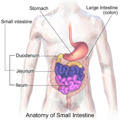Alimentary canal facts for kids
Quick facts for kids Human gastrointestinal tract |
|
|---|---|
 |
|
| Diagram of the Alimentary Canal | |
| Latin | Tractus digestorius (mouth to anus), canalis alimentarius (esophagus to large intestine), canalis gastrointestinales (stomach to large intestine) |
| System | Digestive system |
The gastrointestinal tract (also called the digestive tract or GI tract) is like a long tube inside your body. It's a system of organs in humans and other animals that takes in food, breaks it down to get energy and nutrients, and then gets rid of the waste. Think of it as your body's food processing factory!
Your mouth, esophagus (food pipe), stomach, and intestines are all important parts of this amazing tract. The word gastrointestinal simply means "related to the stomach and intestines." A "tract" is just a group of connected body parts or organs that work together.
Contents
What is the Gastrointestinal Tract?
The gastrointestinal tract is a long, winding pathway that food travels through after you eat it. It starts at your mouth and ends at your anus. Along this path, your body works hard to digest food, which means breaking it down into tiny pieces that your body can use for energy and growth.
How Food Travels Through Your Body
When you eat, food goes on an incredible journey. First, you chew it in your mouth. Then, it slides down your esophagus into your stomach. After that, it moves into your small intestine, and finally into your large intestine. Each part of this journey helps your body get what it needs from your food.
The Role of Digestion
Digestion is the process of changing food into simpler substances. These substances, like sugars, fats, and proteins, are then absorbed into your blood. Your blood carries these nutrients all over your body to give you energy for playing, learning, and growing. Anything your body doesn't need or can't use becomes waste and leaves your body as feces.
Tiny Helpers in Your Gut
Did you know your gastrointestinal tract is home to trillions of tiny living things called microbes? Most of these are different types of bacteria. There are thousands of different kinds, and they all play important roles!
Why Microbes Are Important
These friendly microbes help keep your immune system strong, which means they help your body fight off sickness. They also help with your metabolism, which is how your body uses food for energy. It's like having a whole team of tiny helpers working inside you!
How Long Does Food Stay Inside You?
The time it takes for food to travel all the way through your gastrointestinal tract can be different for everyone. It depends on many things, like what you ate and how fast your body works.
The Journey of a Meal
Here's a general idea of how long food stays in each part:
- After a meal, about half of the food leaves your stomach and goes into your intestines in less than an hour.
- Your stomach usually empties completely in about 2 hours.
- Food then spends about 1 to 2 hours moving through your small intestine.
- Finally, it can take anywhere from 12 to 50 hours for food to pass through your large intestine. This part varies a lot from person to person!
Images for kids
See also
 In Spanish: Tracto gastrointestinal para niños
In Spanish: Tracto gastrointestinal para niños


